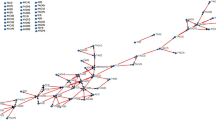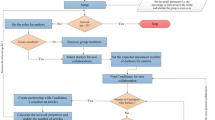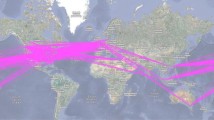Abstract
In this paper the relationship between knowledge production and the structure of research networks in two scientific fields is assessed. We investigate whether knowledge production corresponds positively or negatively with different types of social network structure. We show that academic fields generate knowledge in different ways and that within the fields, different types of networks act as a stimulant for knowledge generation.






Similar content being viewed by others
Notes
We are aware and indeed have highlighted the fact in previous publications, that knowledge generation is not the only task of researchers. Rather, research output is multidimensional and research groups do specialize in different outputs dimensions such as education of new scientists or the maintaining of research infrastructure (Jansen et al. 2007, Schmoch et al. 2009). However, in this paper we concentrate only on the production of new knowledge as one of the core tasks of science because the relationship between knowledge production and network structure has in the past been made repeatedly.
The key-word based search strategy was developed by the Fraunhofer Institute for Systems and Innovation Research ISI. The authors would especially like to thank Ulrich Schmoch and Torben Schubert for collating and providing the relevant data.
A more detailed description of this qualitative way of gathering ego-centred network data is given in Franke and Wald (2006).
Compare http://www.nano.gov/html/facts/whatIsNano.html (as at July 10, 2008).
A key-word based search strategy to identify articles from a field is more precise than a strategy based on the SCI subject categories because journals are assigned to one or more subject categories without discerning for discrete articles. The subject categorisation in the SSCI (which is comparable to the SCI) is discussed in further detail in Glänzel et al. (1999).
The clustering coefficient was introduced by Watts and Strogatz (1998) and can be written as follows:
$$ Clustering\,Coefficient\,\left( C \right) = {\frac{3\; \times \,Number\,of\,Triangles\,on\,the\,Graph}{Number\,of\,connected\,Triples\,of\,Vertices}} $$where a “triangle” is a group of three authors, each of whom is connected to both of the others, and a ‘‘connected triple’’ is a single author connected to two others.
Usually the constraint measure is thought to vary between zero and one, but depending on the size of the network the lower border of the constraint measure will be higher than zero. This is the reason, why the constraint value is higher than zero in our exemplary network B, although there are no crosslinks between the 12 alteri.
We also collected bibliometric data on the number of SCI publications of the research groups between 2004 and 2006 but these data were only available for 49 research groups polled in 2006/07. There is a significant positive correlation between the number of SCI publications and the number of international conference papers of a research group collected by a standardized questionnaire on input and output structure of the research groups (r =0.373**). To allow for a bigger sample size we decided to use the output of international conference papers as the measurement of scientific performance.
The output indicator “number of international conference papers” is a count-variable; therefore only count-data regression models should be applied. First a Poisson-Model was fitted and a test for overdispersion was applied. This test rejected the Poisson-Model on a 0-percent level. A Negative Binomial Model was then computed because the overdispersion-parameters are too high with 0.752 for astrophysics and 0.752 for nanoscience. The dispersion-parameter describes the heteroscedasticity of the model. If the variance is not growing proportional to the expected value of the function, a Negative Binomial Model should be applied, otherwise the significance of the parameters could be overestimated (Hilbe 2007).
We also performed a standard OLS-Regression where we logarithmised the dependent variable “number of international conference papers”. The direction of the effect of network constraint in the two fields is the same as in the Neg-Bin Model; it is significant at the 10%-level for astrophysics and at the 1%-level for nanoscience.
References
Ahuja, G. (2000). Collaboration networks, structural holes, and innovation: A longitudinal study. Administrative Science Quarterly, 45(3), 425–455.
Bachmann, G. (1998). Innovationsschub aus dem Nanokosmos. Technologieanalyse. VDI-Technologiezentrum, Düsseldorf.
Beaver, D. B., & Rosen, R. (1978). Studies in scientific collaboration. Part 1: The professional origins of scientific co-authorship. Scientometrics, 1(1), 65–84.
Blau, P. M. (1977). Inequality and heterogeneity. New York: Free Press.
Bonaccorsi, A. (2007). Explaining poor performance of European science: Institutions versus policies. Science and Public Policy, 34(5), 303–316.
Bonaccorsi, A. (2008). Search regimes and the industrial dynamics of science. Minerva, 46(3), 285–315.
Bonaccorsi, A., & Vargas, J. S. (2007). Proliferation dynamics in emerging sciences. Paper presented at the Conference “Science and its publics”, Munich, 24–25 June 2007. Under review. Retrieved July 14, 2008, from http://www.oecd.org/dataoecd/25/42/40050880.pdf.
Braun, T., Schubert, A., & Zsindely, S. (1997). Nanoscience and nanotechnology on the balance. Scientometrics, 38(2), 321–325.
Bundesministerium für Bildung und Forschung (BMBF). (2004). Nanotechnologie erobert Märkte. Deutsche Zukunftsoffensive für Nanotechnologie, Bonn/Berlin.
Burt, R. S. (1992). Structural holes. Cambridge, MA: Harvard University Press.
Burt, R. S. (2004). Structural holes and good ideas. American Journal of Sociology, 110(2), 349–399.
Burt, R. S. (2008). Information and structural holes: Comment on Reagans and Zuckerman. Industrial and Corporate Change, 17(5), 953–970.
Cohen, W. M., & Levinthal, D. A. (1990). Absorptive capacity: A new perspective on learning and innovation. Administrative Science Quarterly, 35, 128–152.
Coleman, J. S. (1988). Social capital in the creation of human capital. American Journal of Sociology, 94(Supplement), 95–120.
De Solla Price, D. (1963). Little science, big science. New York: Columbia University Press.
EU. (2004). EU policy for Nanosciences and nanotechnologies.
Fernandez, J. A. (1998). The transition from an individual science to a collective one: The case of astronomy. Scientometrics, 42, 61–74.
Feynman, R. (1959). There’s plenty of room at the bottom: An invitation to enter a new field of physics. In Talk at the 1959 meeting of the American Physical Society at California Institute of Technology on December 29, 1959.
Franke, K., & Wald, A. (2006). Möglichkeiten der Triangulation quantitativer und qualitativer Methoden in der Netzwerkanalyse. In B. Hollstein & F. Straus (Eds.), Qualitative Netzwerkanalyse. Konzepte, Methoden, Anwendungen (pp. 153–176). Wiesbaden: VS Verlag.
Franke, K., Wald, A., & Bartl, K. (2006). Die Wirkung von Reformen im deutschen Forschungssystem. Eine Studie in den Feldern Astrophysik, Nanotechnologie und Mikroökonomie, Speyer Forschungsberichte Nr. 245, Speyer.
Gibbons, M., Limoges, C., Nowotny, H., Schwartzmann, S., Scott, P., & Trow, M. (1994). The new production of knowledge. The dynamics of science and research in contemporary societies. London: Sage.
Glänzel, W., Schubert, A., Schoepflin, U., & Czerwon, H.-J. (1999). An item-by-item subject classification of papers published in journals covered by the SSCI database using reference analysis. Scientometrics, 46, 431–441.
Grabher, G. (1993). The weakness of strong ties: The lock-in of regional development in the Ruhr Area. In G. Grabher (Ed.), The embedded firm. On the socio-economics of industrial networks. London: Routledge.
Granovetter, M. (1973). The strength of weak ties. American Journal of Sociology, 78, 1360–1380.
Heidenreich, M. (2000). Regionale Netzwerke in der globalen Wissensgesellschaft. In J. Weyer (Ed.), Soziale Netzwerke. Konzepte und Methoden der sozialwissenschaftlichen Netzwerkforschung (pp. 87–110). München und Wien: Oldenbourg.
Heinze, T. (2009). Nanoscience and technology. In D. Jansen (Ed.), Governance and performance in the German public research sector. Disciplinary differences. Dordrecht: Springer (forthcoming).
Heinze, T., & Bauer, G. (2007). Characterizing creative scientists in nano-S&T: Productivity, multidisciplinarity, and network brokerage in a longitudinal perspective. Scientometrics, 70(3), 811–830.
Hessels, L. K., & van Lente, H. (2008). Re-thinking new knowledge production: A literature review and a research agenda. Research Policy, 37(4), 740–760.
Hilbe, J. M. (2007). Negative binomial regression. Cambridge: University Press.
Jacob, M. (2001). Managing the institutionalisation of mode 2 knowledge production. Science Studies, 14(2), 83–100.
Jansen, D. (1996). Nationale Innovationssysteme, soziales Kapital und Innovationsstrategien von Unternehmen. Soziale Welt, 45, 411–434.
Jansen, D. (2002). Netzwerkansätze in der Organisationsforschung. In J. Allmendinger & T. Hinz (Eds.), Organisationssoziologie (pp. 88–118) Sonderband 42 der Kölner Zeitschrift für Soziologie und Sozialpsychologie.
Jansen, D. (2004). Networks, Social Capital and Knowledge Production, Forschungsinstitut für öffentliche Verwaltung, Discussion Papers No. 8, Speyer.
Jansen, D., von Görtz, R., & Heidler, R. (2009). Is nanoscience a mode-2 field? Disciplinary differences in modes of knowledge production and the influence of science policy on these differences. In D. Jansen (Ed.), Governance and performance in the German public research sector. Disciplinary differences. Dordrecht: Springer (forthcoming).
Jansen, D., Wald, A., Franke, K., Schmoch, U., & Schubert, T. (2007). Drittmittel als Performanzindikator der wissenschaftlichen Forschung. Zum Einfluss von Rahmenbedingungen auf Forschungsleistung. Kölner Zeitschrift für Soziologie und Sozialpsychologie, 59(1), 125–149.
Kearnes, M. B., & Macnaghten, P. M. (2006). (Re)Imaging nanotechnology. Science as Culture, 15(4), 279–290.
Kuhn, T. S. (1957). The Copernican revolution. Cambridge, MA: Harvard University Press.
Kuhn, T. S. (1970, first edition 1962). The structure of scientific revolutions, 2nd edn enl., Chicago: University of Chicago Press.
Leung, R. (2007). Network position, research funding, and interdisciplinary collaboration among nanotechnology scientists: An application of social network analysis. Solid State Phenomena, 121–123, 1347–1350.
Leydesdorff, L., & Rafols, I. (2009). A global map of science based on the ISI subject categories. Journal of the American Society for Information Science and Technology, 60(2), 348–362.
Mayntz, R. (1992). Modernisierung und die Logik von interorganisatorischen Netzwerken. Journal für Sozialforschung, 32, 19–32.
McCray, W. P. (2000). Large telescopes and the moral economy of recent astronomy. Social Studies of Science, 30(5), 685–711.
Meyer, M. (2005). Between technology and science. Exploring an emerging field. Knowledge flows and Networking on the Nano-scale. Florida: Dissertation.com.
Mody, C. (2004). How probe microscopists became nanotechnologists. In D. Baird, A. Nordmann, & J. Schummer (Eds.), Discovering the nanoscale (pp. 119–133). Amsterdam: IOS Press.
Newman, M. E. J. (2001). Scientific collaboration networks. I. Network construction and fundamental results, Physical Review E, 64, 1–8.
Polanyi, M. (1985). Implizites Wissen. Frankfurt am Main: Suhrkamp.
Powell, W. (1990). Neither market nor hierarchy: Network forms of organization. Research in organizational behavior, 12, 295–336.
Reagans, R., & Zuckerman, E. (2008). Why knowledge does not equal power: The network redundancy trade-off. Industrial and Corporate Change, 17(5), 903–944.
Roco, M., & Bainbridge, W. (Eds.). (2002). Converging technologies for improving human performance. Arlington, Virginia: National Science Foundation.
Schmoch, U., Schubert, T., Jansen, D., Heidler, R., & von Görtz, R. (2009). How to use indicators to measure scientific performance? A balanced approach. To be published in Research Evaluation.
Schummer, J. (2004). Multidisciplinarity, interdisciplinarity, and patterns of research collaboration in nanoscience and nanotechnology. Scientometrics, 59(3), 425–465.
Wald, A., Franke, K., & Jansen, D. (2007). Governance reforms and scientific production. Evidence from German astrophysics. In D. Jansen (Ed.), New forms of governance in research organizations. Disciplinary approaches, interfaces and integration (pp. 213–232). Dordrecht: Springer.
Walker, G., Kogut, B., & Shan, W. (1997). Social capital, structural holes and the formation of an industry network. Organization Science, 8(2), 109–125.
Watts, D. J., & Strogatz, S. H. (1998). Collective dynamics of “small-world” networks. Nature, 393, 440–442.
Werle, R. (1990). Telekommunikation in der Bundesrepublik: Expansion, Differenzierung, Transformation. Schriften des Max-Planck-Instituts für Gesellschaftsforschung Köln, Bd. 6. Campus, Frankfurt a. M.
Weyer, J. (2000). Zum Stand der Netzwerkforschung in den Sozialwissenschaften. In J. Weyer (Ed.), Soziale Netzwerke. Konzepte und Methoden der sozialwissenschaftlichen Netzwerkforschung (pp. 1–34). München und Wien: Oldenbourg.
Whitley, R. (2000, first edition 1984). The intellectual and social organisation of the sciences, 2nd edn. Oxford: Oxford University Press.
Yayavaram, S., & Ahuja, G. (2008). Decomposability in knowledge structures and its impact on the usefulness of inventions and knowledge base malleability. Administrative Science Quarterly, 53, 333–362.
Acknowledgements
We gratefully acknowledge funding by the German Research Foundation (Ja 548/5-1, Ja 548/5-2, Ja 548/5-3).
Author information
Authors and Affiliations
Corresponding author
Rights and permissions
About this article
Cite this article
Jansen, D., von Görtz, R. & Heidler, R. Knowledge production and the structure of collaboration networks in two scientific fields. Scientometrics 83, 219–241 (2010). https://doi.org/10.1007/s11192-009-0022-1
Received:
Accepted:
Published:
Issue Date:
DOI: https://doi.org/10.1007/s11192-009-0022-1




